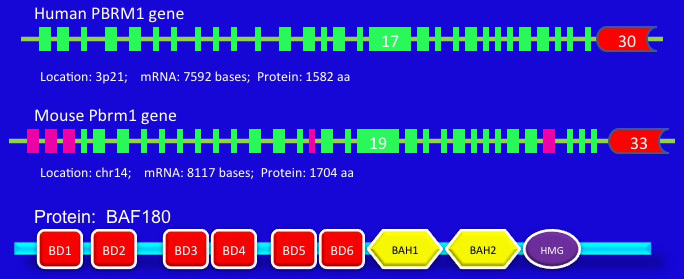Kidney-specific knockout mouse modeling via conditional disruption of PBRM1 gene
Recently, a new kidney cancer-related gene PBRM1 was identified through exome sequencing in a series of primary clear cell renal carcinoma (ccRCC). Study showed that around 40% examined cases carried PBRM1 gene mutations, indicating PBRM1 is the second most important kidney cancer-related gene following VHL gene whose mutations account for approximate 70% of ccRCC cases.
Human PBRM1 gene lies on 3p21, contains 30 exons (variant 1), and encodes a protein (BAF180) of 1582 amino acides. The mouse Pbrm1 gene is located on chromosome 14, composed of 33 exons, and encodes a protein of 1704 amino acids.

PBRM1 gene structure and corresponding protein structure.
PBRM1 protein BAF180 is a member of SWI/SNF complex (SWItch/Sucrose NonFermentable). The SWI/SNF complex is an evolutionarily conserved multi-subunit chromatin-remodelling complex, which uses the energy of ATP hydrolysis to mobilize nucleosomes and remodel chromatin. It has been found that the SWI/SNF complex (in yeast) is capable of altering the position of nucleosomes along DNA. Two mechanisms for nucleosome remodeling by SWI/SNF have been proposed. The first model contends that a unidirectional diffusion of a twist defect within the nucleosomal DNA results in a corkscrew-like propagation of DNA over the octamer surface that initiates at the DNA entry site of the nucleosome. The other is known as the "bulge" or "loop-recapture" mechanism and it involves the dissociation of DNA at the edge of the nucleosome with reassociation of DNA inside the nucleosome, forming a DNA bulge on the octamer surface. The DNA loop would then propagate across the surface of the histone octamer in a wave-like manner, resulting in the repositioning of DNA without changes in the total number of histone-DNA contacts. A recent study has provided strong evidence against the twist diffusion mechanism and has further strengthened the loop-recapture model.

The mammalian SWI/SNF complexes mediate ATP-dependent chromatin remodeling processes that are critical for differentiation and proliferation. Not surprisingly, loss of SWI/SNF function has been associated with malignant transformation, and a substantial body of evidence indicates that several components of the SWI/SNF complexes function as tumor suppressors.
To study the biological function of PBRM1and its role in kidney tumorigenesis, we have been developing a few PBRM1 knockout mouse models by deleting the exon 2.

To date, we did not see any apparent phenotype in proximal tubule Pbrm1 knockout mouse model. We are still working on Pbrm1 distal tubule knockout mouse model。
Click here to see BHD knockout mouse models

